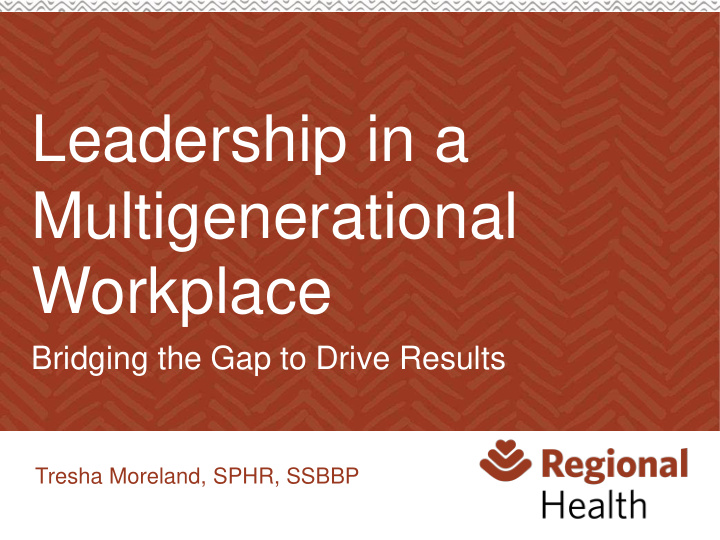



Leadership in a Multigenerational Workplace Bridging the Gap to Drive Results Tresha Moreland, SPHR, SSBBP
Test Your Knowledge
Myth or Reality? The millennial generation is the largest generation of today
Myth or Reality? Only older generations care about organizational purpose
Myth or Reality? Generation Xers and Millennials have no work ethic
Myth or Reality? Younger generations change jobs more often than older generations at the same age
Today’s Objectives
Today’s Objectives Inspire new thought and new action Understand the value of generational differences and similarities How to attract and retain talent in a multigenerational world of work
HR in a Multigenerational World
The Dress Code Traditionalist Dress Respectably
The Dress Code Baby Boomer Business Casual
The Dress Code Generation X Casual Fridays - Jeans
The Dress Code Millennial Face piercings, tongue piercings, non-natural colored hair
A Generational Overview
5 Generations in the Workplace “There is satisfaction of a job well done” Traditionalists • Born 1945 and earlier • Smallest group in the workforce today at 55 million • Born during the hard times of the great depression through WWII • They value hard work • Likes formality, at times may be thought of as inflexible
5 Generations in the Workplace “Somebody has to do something, and it’s just Boomers incredibly pathetic that it has to be us.” Jerry Garcia • Born 1946 and 1964 • Known as the suburban and Woodstock generation • About 76 million • The term “workaholic” was coined for this generation • Strong work ethic • Overabundance of work ethic may have led to a breakdown in family values
5 Generations in the Workplace “Company loyalty must be earned, not Generation X expected” • Born 1965 and 1980 • Known as the forgotten generation • A small generation of about 41 million • Will challenge the status quo • Introduced the work-life balance concept • Skeptical of the institution, leaders and any attempt to engage them
5 Generations in the Workplace Generation Y “Employment is a means to an end.” (or The Millennials) • Born 1977 and 1995 • Recently surpassed Gen X as the largest generation in the workplace – about 77 million • Projected to equal over 50% of the workplace by 2020 • Looks for lifestyle fit over job title or status • Techy and adaptable • Demands recognition for even routine tasks, wants to know “why” before doing anything.
5 Generations in the Workplace Generation Z (or iGen) • Born 1996 or later • Up and coming generation of workers • 23 million and growing • Too soon to generalize about work ethic • Adopted technology at a much younger age • May appreciate more a virtual work collaboration
Differences Perception
Attitudes Towards Work Work Ethic • Boomer Generation: Seen as “workaholics” • Views younger generation as “slackers” • This perception difference may lead to conflict • Studies show: • Each approach tasks differently • Work ethic varies with education, income level and marital status.
Loyalty Towards the Employer Loyalty • Traditionals and Boomers: Seen as extremely loyal • Views younger generation as disloyal • This perception difference may lead to conflict • Studies show: • Employer loyalty does not lead to job security • Would like to advance quicker than parents did • Changing jobs is connected to a good economy • Similar reasons to stay: advancement, learn new skills, better compensation
Attitudes Regarding Respect and Authority Respect and Authority • Traditionals and Boomers: “Do it because I said so” • Views younger generation as disrespectful • This perception difference may lead to conflict • Studies show: • Younger generations complain about managers who ignore ideas • Not impressed with titles • Find it natural to interact with their superiors • Will frequently ask “why”?
Training Styles and Needs Training • Traditionals and Boomers: Soft skills are on the job, hard skills are learned in the classroom. • Views younger generation as disrespectful • Studies show: • Younger generations prefer to learn both soft and hard skills on the job • Prefers peer interaction and feedback • Discussion groups and one-on-one coaching is ideal • Needs frequent assessment and feedback
Valuing Similarities
Concerns Related to Change Change • Doing the same work with fewer resources • Mindful of changes internally and externally • Change that is disorganized, unnecessary or both • Resistance to change
Reasons for Staying in an Organization Retention • Opportunity to advance • Learning and development opportunities • Respect and recognition • Better quality of life • Better compensation
Attitudes Regarding Flexibility Flexibility • Freedom to set own hours if work gets done • Working full time • Option of a four day work week if available
Important Aspects of Workplace Culture Workplace Culture • Fair • Ethical • Straightforward • Collaborative/team feeling • Professional • Friendly/Social
Communication Tools Used for Work Communication Tools • Desktop computer • Landline phone • Fax • Mobile/cell phone • Laptop computer
Top Reasons for Happiness in the Workplace Happiness • Feeling valued • Recognition and appreciated • Supportive Environment
How to Attract and Retain Talent
How to Attract and Retain • Embrace diversity widely and not selectively • Resist buying into age-based stereotypes • Discourage judging and focus on empowering • Leverage Strengths • Traditionalists and Boomers – Good mentors • Generation X – Bridge builders • Millennials – New skills; technology savvy
How to Attract and Retain • Value everyone as individuals • Recognize and reward – with options and flexibility • Build your culture on shared needs of a multigenerational workforce • Engage diverse teams • Teams are made up of individuals with a shared goal • Engage by committing to shared goals
Thank you for the honor of speaking today! Do you have any questions?
Recommend
More recommend